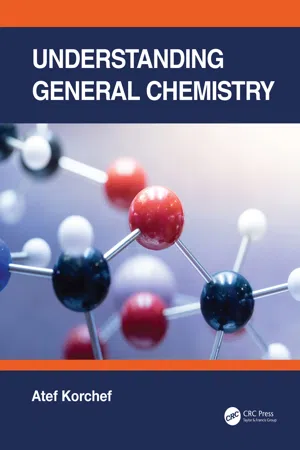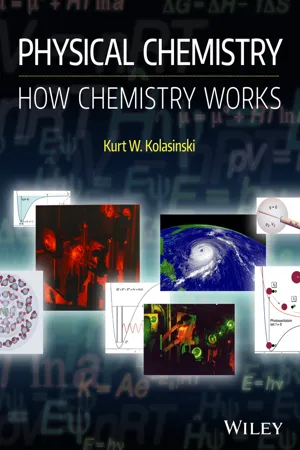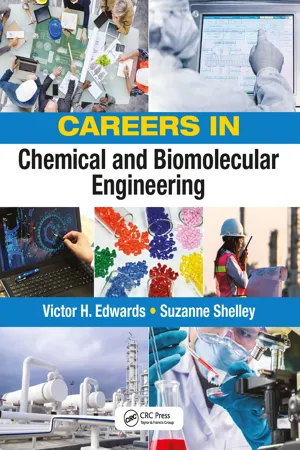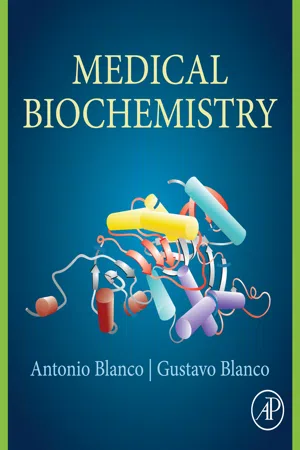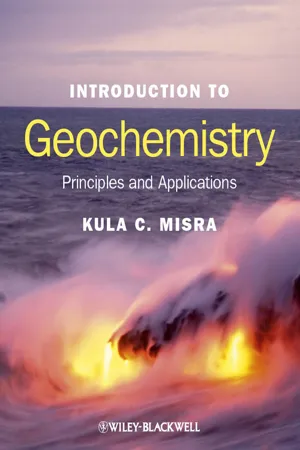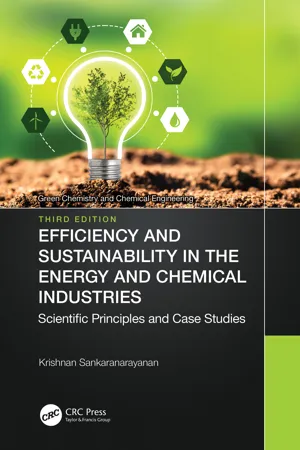Chemistry
Endothermic and Exothermic Processes
Endothermic processes absorb heat from their surroundings, causing a decrease in temperature, while exothermic processes release heat into their surroundings, leading to a temperature increase. In endothermic reactions, the products have more energy than the reactants, while in exothermic reactions, the products have less energy than the reactants.
Written by Perlego with AI-assistance
Related key terms
9 Key excerpts on "Endothermic and Exothermic Processes"
- eBook - ePub
Chemistry
With Inorganic Qualitative Analysis
- Therald Moeller(Author)
- 2012(Publication Date)
- Academic Press(Publisher)
Once the fire has been lit, the chemical reaction keeps going and heat continues to be given off until all of the wood has been consumed. The campfire reaction—the reaction of wood with oxygen—is an exothermic process, a process that releases heat. Like the burning of the campfire, many exothermic reactions keep going once they get started. Some chemical reactions, however, will only proceed if heat is available from an outside source, either the atmosphere or something hotter than that. An endothermic process is a process that absorbs heat. Endothermic processes slow down and stop when not enough heat is available. Physical processes involving atoms, molecules, and ions are also accompanied by thermal energy exchange. Such processes do not produce new chemical compounds, but change the form or state of a substance. For example, characteristic amounts of heat can be measured for pure substances undergoing condensation of a gas to a liquid, or the melting of a solid, or vaporization of a liquid. Such interconversions among the solid, liquid, and gaseous states are called changes of state. All changes of state are either exothermic or endothermic. The amount of thermal energy evolved or absorbed in a change of state reflects the strength of intermolecular forces —the various forces of attraction or repulsion between individual molecules (Figure 5.1). For example, consider the conversion of water to steam at 100°C. It may be a surprise at first to realize that heat added to water at 100°C does not raise the temperature of the water. The added thermal energy is used to separate the molecules in the liquid state from each other’s influence and drive them off into the gaseous state, where they are further apart. Similarly, heat removed from water vapor at 100°C does not cool the vapor, but only causes it to condense - eBook - ePub
- Atef Korchef(Author)
- 2022(Publication Date)
- CRC Press(Publisher)
5 Thermochemistry
DOI: 10.1201/9781003257059-55.1 Objectives
At the end of the present chapter, the student will be able to:- Define energy, work and heat.
- Distinguish between the system and the surroundings.
- Define exothermic and endothermic processes.
- Define the internal energy and the enthalpy of a system.
- Perform calculations involving change of energy.
- Define calorimetry and distinguish between specific heat and heat capacity.
- Recognize the different phase changes of a substance and calculate the heat absorbed or released during phase changes.
- Define the standard enthalpy of formation and the bond enthalpy.
- Recognize Hess’s law and calculate the enthalpy of reaction.
- Define the Born-Haber cycle and calculate the lattice enthalpy change of ionic compounds.
5.2 Energy, Heat and Work
Energy is the capacity to do work. Energy cannot be created or destroyed; it can only be transformed. The science that concerns the study of energy and its transformation is thermodynamics and the branch of thermodynamics which concerns the study of heat energy changes associated with chemical reactions or physical changes is called thermochemistry. In thermochemistry, we often concern ourselves with energy transfer as work (w) or as heat (q). Heat is the transfer of thermal energy (defined as the kinetic energy related to the random motion of atoms or molecules) between two matters at different temperatures. Matter can absorb or release heat during a chemical reaction or a physical process. Work is the energy used to cause an amount of matter to move. Work (w) can be calculated by the following equation:
where F is the applied force and d is the distance traveled by the matter due to this force.w = F × d5.3 System and Surroundings
The system is a portion of space which includes the particles of interest that we are studying. The surroundings are everything else. For example, if we are interested in the combustion reaction of methane (CH4 ) with oxygen (O2 ) in a cylinder, then CH4 and O2 in the cylinder form the system, and everything else is the surroundings. The entire system and surroundings constitute the universe. The system is bounded by a real or fictitious surface through which the exchanges of energy and matter are made with the surroundings (Figure 5.1 - eBook - ePub
Physical Chemistry
How Chemistry Works
- Kurt W. Kolasinski(Author)
- 2016(Publication Date)
- Wiley(Publisher)
CHAPTER 10 Thermochemistry: The role of heat in chemical and physical changesPREVIEW OF IMPORTANT CONCEPTS
- The standard state of a substance is its pure form in equilibrium at 1 bar.
- Δr H° < 0 defines an exothermic reaction. Δr H° > 0 defines an endothermic reaction.
- Energy is not released from bonds when they are broken. Energy is released from a reactive system when weaker bonds are replaced by stronger bonds being formed.
- In an exothermic reaction, weaker bonds are broken on average in the reactants and stronger bonds are made in the products.
- Calorimetry – the science of the measurement of heat exchange associated with a process – is the standard method for determining the enthalpy change during a reaction.
- The heat exchanged at constant pressure is equal to the enthalpy change.
- The heat exchanged at constant volume is equal to the internal energy change.
- Enthalpy is a state function, which leads to Hess's law: The standard enthalpy of an overall reaction is the sum of the standard enthalpies of the individual reactions into which a reaction may be divided.
- The enthalpy change of any reaction can be calculated from the enthalpies of formation of the reactants and products.
- Heat capacity is a temperature-dependent quantity.
- Changes in the heat capacity between reactants and products are responsible for the changes in reaction enthalpy with temperature.
Thermochemistry lies at the heart of one of the areas that makes chemistry so important. Energy can be extracted from a chemical system when bonds are rearranged in the making of products from reactants. This energy can be harvested to perform work, to generate steam and electricity, and to provide warmth in our homes. The energy changes that occur during reactions and phase changes are directly dependent on bonding and intermolecular interactions. Thus, the measurement of temperature changes during these processes is a direct measure of the strength of these interactions. By probing the strength of bonds and intermolecular interactions, thermochemical measurements provide tests to our models of these interactions. - eBook - ePub
- Victor Edwards, Suzanne Shelley(Authors)
- 2018(Publication Date)
- CRC Press(Publisher)
5 Basic Concepts: Equilibrium and Rate ProcessesThermodynamicsFundamental definitions in thermodynamicsThermodynamics is a branch of physics that is concerned with temperature and heat, and their relation to energy and work in macroscopic systems (Van Ness and Abbott 2008). There are four laws of thermodynamics (discussed below) that apply to thermodynamic systems, such as heat engines or chemically reacting substances. There are numerous other equations that derive from those laws, and those equations allow users to predict the outcome of physical and chemical phenomena involving thermodynamic systems.Chemical thermodynamics is the study of the interrelation of energy with chemical reactions or with a physical change of state, within the confines of the laws of thermodynamics. Numerous chemical engineering unit operations and processes can be represented as thermodynamic systems for the purposes of analysis and design.Conceptually, in thermodynamics, a system may be an object, a quantity of matter, or a region of space that is selected for study and set apart (conceptually) from everything else; the “everything else” is referred to as the surroundings (Van Ness and Abbott 2008). The boundary of the system can be imagined as an envelope that encloses the system and separates it from its surroundings.A system can interact with its surroundings in several ways. If there is no interaction, the system is said to be isolated . A system that is not isolated may allow the exchange of energy and/or material across its boundary. A system that allows exchange of matter is said to be open . If energy can exchange between the system and the surroundings, but no matter can be exchanged, the system is said to be closed .Initially, changes in temperature or pressure may occur within an isolated system, even if there is no exchange of matter or energy with the surroundings. However, these changes eventually stop, and the system is said to be in a final static state of internal equilibrium (Figure 5.1 - eBook - ePub
- Antonio Blanco, Gustavo Blanco(Authors)
- 2017(Publication Date)
- Academic Press(Publisher)
Chapter 7Elements of Thermodynamics and Biochemical Kinetics
Abstract
Chemical reactions proceed with energy changes. Heat is one of the most common forms of energy and it is easy to measure. At constant pressure and temperature, the change in heat is the change in enthalpy (∆H ). Free energy (G ) is the fraction of released energy available to perform work. The free energy change (∆G ) of a reaction is given by the equation: ∆G = ∆H – T · ∆S . A reaction occurs spontaneously when the change in G (∆G ) is negative. The tendency to increase entropy (S, increased disorder) determines the reaction direction. All processes occur with free energy decrease until equilibrium is reached, in which G is minimal. Reactions with negative ∆G are exergonic, while those with positive ∆G are endergonic. Endergonic reactions are possible when coupled with others sufficiently exergonic. ATP, energy rich compound, participates in coupled reactions. Chemical reactions can be coupled when the product of one of them is a reagent for the next. In this case, the overall process ∆G equals the sum of ∆G of individual reactions. In biochemical transformations, endergonic reactions are possible by coupling them with other sufficiently exergonic, so that the overall ∆G is negative. From a kinetic standpoint, reactions can be classified according to the relationship between the reaction rate and the concentration of reactants. A reaction is zero order when the rate of reaction is constant regardless of the reagent concentration. It is first order when the rate is directly proportional to the reactant concentration. Activation energy is the energy needed by the reactants to reach the transition or activated state, from which the reaction can proceed spontaneously. Catalysts - eBook - ePub
- Vladimir Danek †(Author)
- 2006(Publication Date)
- Elsevier Science(Publisher)
The heat measurement of various reactions is the Þrst step in entering the realm of thermodynamics. Every study of any chemical process starts with the laboratory work connected with the Þrst law of thermodynamics. On the other hand, when the thermodynamic considerations do not lead to a reasonable result, it is necessary to go back to the laboratory work.The basic unit of heat is joule (J). The older unit is calorie (cal). The relation between them is 1 J = 4.314 cal.4.1 THERMODYNAMIC PRINCIPLES
The measurement of enthalpy, or heat, of different chemical processes is the objective of the Þrst thermodynamic principle Đ the law of energy conservation. Every chemical process is connected with a certain amount of enthalpy, which the system receives from or delivers to the surroundings.Consider a closed system in which a chemical reaction takes place and that can exchange only heat with the surroundings. During the reaction, an amount of heat is liberated to the surroundings. We can deÞne the function U Đ internal energy, as the energy, which the system has exchanged with the surroundings at transition from the start to the Þnal state. The change in the internal energy for this process is given by the sum of the heat delivered to the system and the exerted workd U = d Q + d W(4.1)(4.1)Equation (4.1) is the mathematical expression of the Þrst law of thermodynamics. In the adiabatic process, the system does not exchange heat with the surroundings, thus(4.2)d Q = 0andd U = d W(4.2)and for the adiabatic expansion, it holdsd U = P d V(4.3)(4.3)Similarly, when the system does not exchange work with the surroundings, then(4.4)d W = 0andd U = d Q(4.4)In both the cases, the change in the internal energy depends only on the starting and Þnal state of the system.From experience, we know that work can be changed to heat (e.g. heating of the liquid at mixing). There is thus an equivalence of work W and heat Q :W = J · Q , where J is a physical quantity called the mechanical equivalent of heat and its value and the dimensions are: J - eBook - ePub
Introduction to Geochemistry
Principles and Applications
- Kula C. Misra(Author)
- 2012(Publication Date)
- Wiley-Blackwell(Publisher)
r values are negative for exothermic reactions and positive for endothermic reactions. In general, the enthalpy of a reaction is not a measure of its tendency to occur.The free energy change of a chemical reaction at the temperature and pressure of interest, which takes into account changes in both enthalpy and entropy, allows us to answer two important questions about chemical reactions: (i) are the reactants and products in equilibrium? and (ii) if not in equilibrium, in which direction would the spontaneous reaction proceed to achieve equilibrium? The rules may be summarized as follows (Fig. 4.8 ):(1) the reactants and products are in equilibrium at the P and T of interest.(2) the reaction should be expected to proceed spontaneously in the direction of the product assemblage, which has a lower free energy and thus is more stable than the reactant assemblage at the P and T of interest.(3) the reaction should be expected to proceed spontaneously in the direction of the reactant assemblage, which has a lower free energy and thus is more stable than the product assemblage at the P and T of interest.Fig. 4.8Schematic illustration of the change in Gibbs free energy of a system (G ) consisting of two pure phases, A and B, as a function of the extent of reaction (ξ) between A and B at constant temperature (T ) and pressure (P ). Starting with either pure A or pure B, G of the system decreases with increasing ξ and reaches a minimum at equilibrium. At equilibrium, ΔG r , P T = 0.The magnitude of for a reaction may be looked upon as a measure of the “driving force” for the reaction, but - eBook - ePub
Efficiency and Sustainability in the Energy and Chemical Industries
Scientific Principles and Case Studies
- Krishnan Sankaranarayanan(Author)
- 2023(Publication Date)
- CRC Press(Publisher)
Thermodynamic Analysis of ProcessesDOI: 10.1201/9781003304388-7He who would learn to fly one day must first learn to stand and walk and run and climb and dance. One cannot fly into flying.—F. NietzschePart II covers Chapters 6 through 8 . In Chapter 6 , the reader is introduced to the principles of the thermodynamic, or exergy, analysis of processes. Two new concepts are introduced: the concept of exergy (or available work), which enables and facilitates the integration of the environment into the analysis of the process, and the concept of the quality of the Joule, which helps to distinguish between “apples and pears” when one speaks about “energy.” Chapter 7 concentrates on the chemical component of exergy. Chapter 8 presents some simple examples of the application of exergy analysis.Passage contains an image
6 Exergy, a Convenient ConceptDOI: 10.1201/9781003304388-86.1 Exergy
In view of the presentation of material in Part I , we can state that every task that we set ourselves in industry implies lost work. This holds for processes producing work equally well as for those requiring work. The challenge is to understand the nature of this lost work and from there to apply originality and intelligence to reduce it.In the following, we deal with a steady-state flow process and consider a flow originally at ambient conditions, P0 and T0 , and requiring work at the rateto bring its conditions at P and T (Figure 6.1 ). In the process, heat is transferred to the environment at a rate ofW ˙i n.Q ˙o u tAs is justified for most situations in process technology, we ignore macroscopic changes in the kinetic and/or potential energy of the flow in this process. Applying the first law of thermodynamics for flow processes, we may write - eBook - ePub
- Nils O. Petersen(Author)
- 2017(Publication Date)
- CRC Press(Publisher)
6The basics of thermodynamics
6.1 SOME BASIC CONCEPTS
Thermodynamics refers to the field of chemistry which is concerned with understanding the flow of energy within a system or when a system changes from one state to another. One ultimate purpose of thermodynamics is to predict whether a change will occur spontaneously. The field of thermodynamics is based on three fundamental laws which lead to a set of parameters such as the free energy and the chemical potential, which are key to our understanding of spontaneous change.In contrast to the field of quantum mechanics, the field of thermodynamics is, to a first approximation, not concerned with the detailed structures of the materials, and hence the outcomes become very generally applicable.Our first task is to remind ourselves of some basic concepts of systems and how we describe these.A system is simply that region of space or matter that we are interested in understanding. The surroundings of the system is everything else —in principle, everything else in the universe, but in practice everything else that matters, such as the laboratory in which we study the system. For example, the system could be a gas held in a glass container, with the surroundings being the glass container and everything around it. Similarly, the system could be a solution of molecules in a solvent where the system is the molecules in solution and the surroundings include the solvent, the container and everything around it.We characterize a system by a number of functions (or variables) that tell us something unique about the system. Examples would be the temperature of the system, the pressure of the system, the volume of the system, the mass (or the number of molecules) in the system, and the energy of the system. If the state of the system changes, we expect one or more of these functions to change as well, for example, if the number of molecules in the system changes, the volume might change; or if a chemical reaction occurs, the temperature might change. In the context of thermodynamics we are most interested in understanding the change in energy, which is in turn often related to the changes in temperature, pressure, volume, and mass.
Index pages curate the most relevant extracts from our library of academic textbooks. They’ve been created using an in-house natural language model (NLM), each adding context and meaning to key research topics.

